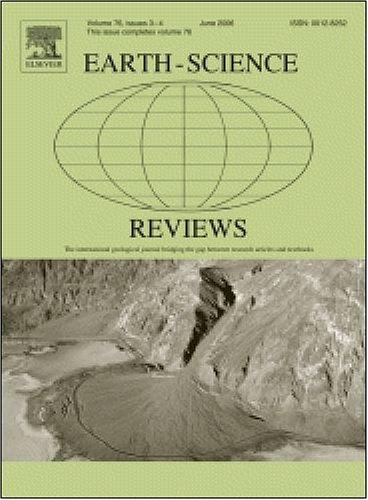Evolutionary paleoecology of macroscopic symbiotic endobionts in Phanerozoic corals
IF 10.8
1区 地球科学
Q1 GEOSCIENCES, MULTIDISCIPLINARY
引用次数: 0
Abstract
Symbiotic associations are key interactions in benthic ecosystems; they drive evolutionary changes that influence the complexity of life. Out of the major groups of Phanerozoic corals, scleractinians, established the highest number of symbiotic associations, followed by tabulate and rugose corals. Corals were most frequently associated with "worms", followed by arthropods, mollusks, lophophorates, and other corals. Parasitic relationships were more common than commensal or mutualistic ones. Symbiotic skeletal organisms colonized Phanerozoic corals more often than soft-bodied organisms were recorded as bioclaustrations. Among these symbionts, suspension feeders were the dominant group, though micro-predators, detritivores and carnivores were also present. The faunal composition of endobiotic coral symbionts closely mirrors Sepkoski's evolutionary faunas. Paleozoic corals were primarily associated with species from the Paleozoic evolutionary fauna, while Mesozoic to Cenozoic corals were inhabited by members of the modern fauna. The most intriguing aspect is that there was no significant escalation in coral symbiosis levels during the Paleozoic. While the increase in predation intensity throughout the Phanerozoic is well-documented, a similar pattern in symbiotic relationships is not observed. Both tabulate and rugose corals maintained relatively stable, group-specific levels of symbiosis throughout the Paleozoic. The apparent lack of data from the Permian may be due to study and sampling biases. Similarly, scleractinians show no significant increase in symbiosis from the Jurassic to the Paleogene. These findings suggest that the evolution of symbiotic relationships may have been less competitive compared to predation, which involves continuous escalation between predators and prey. It also implies that certain organism groups may quickly reach an optimal level of symbiosis, beyond which further symbiotic relationships offer no additional evolutionary advantage compared to non-symbiotic taxa.
显生宙珊瑚宏观共生内生生物的进化古生态学
共生关系是底栖生态系统中关键的相互作用;它们推动了影响生命复杂性的进化变化。在显生珊瑚的主要类群中,硬核珊瑚建立了最多的共生关系,其次是表状珊瑚和皱状珊瑚。珊瑚最常与“蠕虫”联系在一起,其次是节肢动物、软体动物、磷光动物和其他珊瑚。寄生关系比共生关系或互惠关系更为常见。共生骨骼生物比软体生物更常在显生宙珊瑚中定居,被记录为生物螯合。在这些共生体中,悬浮捕食者是优势群体,但也存在微捕食者、腐食动物和食肉动物。内生珊瑚共生体的动物群组成与塞普科夫斯基的进化动物群密切相关。古生代珊瑚主要与古生代进化动物群的物种有关,而中生代至新生代珊瑚则与现代动物群的成员有关。最有趣的是,在古生代,珊瑚共生水平没有显著上升。虽然在显生宙中捕食强度的增加是有目共睹的,但在共生关系中没有观察到类似的模式。在整个古生代,表状珊瑚和皱状珊瑚都保持了相对稳定的、特定群体的共生水平。二叠系数据的明显缺乏可能是由于研究和抽样偏差。同样,从侏罗纪到古近纪,硬核动物的共生关系也没有明显增加。这些发现表明,与捕食者之间的不断升级相比,共生关系的进化可能缺乏竞争。这也意味着某些生物群体可能很快达到最佳的共生水平,超过这个水平,进一步的共生关系与非共生分类群相比没有额外的进化优势。
本文章由计算机程序翻译,如有差异,请以英文原文为准。
求助全文
约1分钟内获得全文
求助全文
来源期刊

Earth-Science Reviews
地学-地球科学综合
CiteScore
21.70
自引率
5.80%
发文量
294
审稿时长
15.1 weeks
期刊介绍:
Covering a much wider field than the usual specialist journals, Earth Science Reviews publishes review articles dealing with all aspects of Earth Sciences, and is an important vehicle for allowing readers to see their particular interest related to the Earth Sciences as a whole.
 求助内容:
求助内容: 应助结果提醒方式:
应助结果提醒方式:


